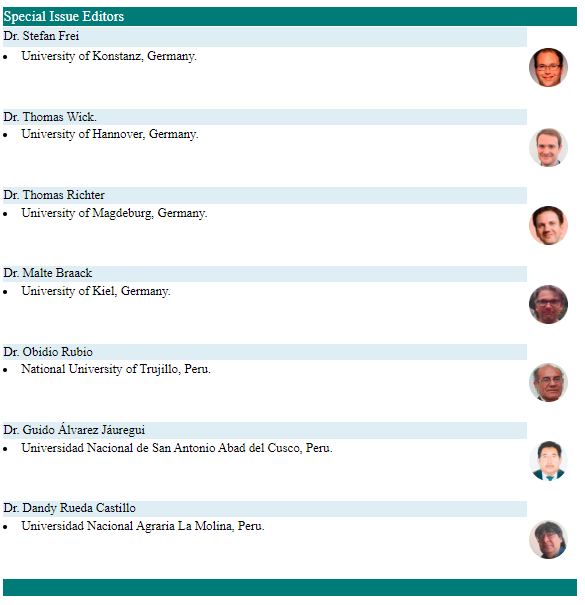Mathematical model for the study of the diffusion of Zika. Computational experimentation in Paramaribo and Santa Ana
DOI:
https://doi.org/10.17268/sel.mat.2019.02.06Palabras clave:
Difusión, epidemia, modelo, ZikaResumen
El virus del Zika se propaga a las personas principalmente a través de la picadura de un mosquito de la especie Aedes Aegypti infectado. El Zika también puede transmitirse a través del sexo de una persona infectada a sus parejas sexuales y se puede transmitir de una mujer embarazada a su feto. El Zika continúa expandiéndose geográficamente a áreas donde están presentes vectores competentes. Si bien se ha informado una disminución en los casos de infección por el virus del Zika en algunos países o en algunas partes de los países, la vigilancia debe mantenerse alta. En este trabajo proponemos un modelo matemático que utiliza ecuaciones de difusión-advección para estudiar el impacto de la epidemia de Zika. Presentamos un esquema numérico vinculando elementos finitos (FEM) con diferencias finitas para resolver el modelo. Las simulaciones computacionales se realizan para Paramaribo y Santa Ana, que tienen diferentes características demográficas y nos permiten ampliar el estudio a otras regiones.Citas
Butcher, J. C. Numerical method for ordinary differential equations, JohnWiley and Sons, 2003. doi: 10.1002/9780470753767.
Ciarlet, P. G. The finite element method for elliptic problem, SIAM, 2002. ISBN: 978-0898715149.
Crank, J. and Nicolson, E. A practical method for numerical evaluation of partial differential equations of the heat conduction type, Proc. Camb. Phil. Soc., 1947; 43(1):50-67. doi:10.1017/S0305004100023197.
Dick, G. W. A., Kitchen, S. F. and Haddow, A. J. Zika Virus. I. Isolations and serogical specifity, Trans R Soc Trop Med Hyg, 1952; 46(5):509-520. doi:10.1016/0035-9203(52)90042-4.
Dick, G. W. A., Kitchen, S. F. and Haddow, A. J. Zika virus (II). Pathogenicity and physical properties, Trans R Soc Trop Med Hyg, 1952; 46:521-534. doi:10.1016/0035-9203(52)90043-6.
Bonyah Ebenezer and Okosun Kazeem. Mathematical Modelling of Zika virus. Asian Pacific Journal of Tropical Disease. doi:10.1016/S2222-1808(16)61108-8
Delgado, E. M. and Marrero S. A. Mathematical models for Zika with exposed variables and delay. Comparison and experimentation in Suriname and El Salvador, Selecciones Matemáticas, ISSN: 2411-1783, 2019. doi:10.17268/sel.mat.2019.01.01.
Kassen, T. G. and Garba, E. J. D. A mathematical model for the spatial spread oh HIV in heterogeneous population, Mathematical Theory and Modeling, 2016; 6(4):95-104. ISSN: 2224-5804.
Lin, H. and Wang, F. On a reaction-diffusion system modeling the Dengue transmission with nonlocal infections and crowding effects, Applied Mathematics and Computation, 2014; 248:184-194. doi: 10.1016/j.amc.2014.09.101.
Lotfi, E. M., Maziane, M., Hattaf, K. and Yousti, N. Partial differential equations of an epidemic model with spatial difussion, International Journal of Partial Differential Equations, volume 2014, article ID 186437, 2014. doi: 10.1155/2014/186437
Macufa, M. M., Mayer, J. F. and Krindges, A. Difussion of Malaria in Mozambique. Modeling with computational simulations, Biomatemática, 2015; 25:161-184.
Maidana, N. A. and Yang, H. M. A spatial model to describe the Dengue propagation, TEMA, Tend. Mat. Apli. Comp., 2007; 8(1):83-92. ISSN: 1677-1966.
Prevention of sexual transmission of Zika virus: interim guidance update, Geneva: World Health Organization; 2016 (WHO/ZIKV/MOC/16.1 Rev.3; https://apps.who.int/iris/handle/10665/204421)
Peng, R. and Zhao, X. Q. A reaction-diffusion SIS epidemic model in a time periodic environment, Nonlinearity, 2012; 25:1451-1471. DOI: 10.1088/0951-7715/25/5/1451.
X. Ren, Tian, Y., Liu, L. and Liu, X. A reaction difussion withen-host HIV model with cell-to-cell transmision, J. Math. Biol., 2018; 76:1831-1872. DOI: 10.1007/s00285-017-1202-x.
Shutt, D. P., Manore, C. A., Pankavich, S., Porter, A. T. and del Valle, S. Y. Estimating the reproductive number, total outbreak size, and reporting rates for ZIKA epidemics in South and Central America, Epidemics, 2017; 21:63-79. DOI:10.1016/j.epidem.2017.06.005.
Tiemi, T. T., Maidan, N. A., Ferreira Jr, W. C., Paulino, P. and Yang, H. Mathematical Models for the Aedes aegypti dispersal dynamics: Travelling waves by wing and wind, Bulletin of Mathematical Biology, 2005; 67:509-528. DOI:10.1016/j.bulm.2004.08.005.
Descargas
Publicado
Cómo citar
Número
Sección
Licencia
Los autores/as que publiquen en esta revista aceptan las siguientes condiciones:
- Los autores/as conservan los derechos de autor y ceden a la revista el derecho de la primera publicación, con el trabajo registrado con la licencia de atribución de Creative CommonsAtribución 4.0 Internacional (CC BY 4.0) , que permite a terceros utilizar lo publicado siempre que mencionen la autoría del trabajo y a la primera publicación en esta revista.
- Los autores/as pueden realizar otros acuerdos contractuales independientes y adicionales para la distribución no exclusiva de la versión del artículo publicado en esta revista (p. ej., incluirlo en un repositorio institucional o publicarlo en un libro) siempre que indiquen claramente que el trabajo se publicó por primera vez en esta revista.
- Se permite y recomienda a los autores/as a publicar su trabajo en Internet (por ejemplo en páginas institucionales o personales) antes y durante el proceso de revisión y publicación, ya que puede conducir a intercambios productivos y a una mayor y más rápida difusión del trabajo publicado(Consultar: efecto del acceso abierto).













